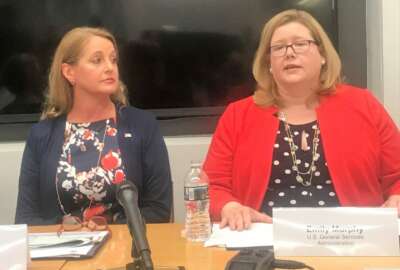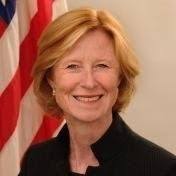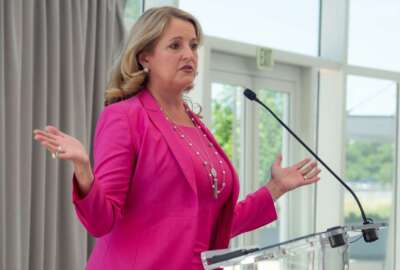
GSA almost ready to launch first set of modernized payroll services
GSA’s NewPay and DHS’ cyber quality service management office (QSMO) are going to be the first initiatives out of the gate with new capabilities in 2021, while...
The governmentwide initiative to modernize payroll services is ready to come out from behind the curtain two years after launching. The General Services Administration expects to deliver its first set of capabilities under the NewPay program this fall.
NewPay and the cybersecurity quality service management offices (QSMO) will lead the administration’s effort to get shared services out of the starting gate in fiscal 2021.
GSA launched NewPay in September 2018 with awards to two teams of vendors, received $20.6 million from the Technology Modernization Fund in 2019, issued a request for information and then task orders against the blanket purchase over the last year.
Along with the task orders, Amy Haseltine, the director of the Quality Service Management Office for civilian human resource transaction service and director of the NewPay Management Office at GSA, said her office has focused on four areas: engagement with agency stakeholders and industry, technical configuration and design of new capabilities, data standards and governance.

Of those four, the QSMO is ready to demonstrate the progress in two of those areas in the short term.
She said a minimally viable product (MVP) for NewPay is almost ready.
“The MVP will help us actually calculate payroll in a consistent, complete and holistic manner. This calculation and this tool that we are designing covers 65 major pay plans across the federal space, which will actually help pay approximately 89% of our workforce,” Haseltine said during the Shared Services Summit sponsored by ACT-IAC and the Shared Services Leadership Coalition. “We are in process of finishing that minimally viable product. We’ve actually used testing data to test 12 of the 65 pay plans. Of the 65 pay plans, we will be incorporating the Title V or general schedule population, so we are very excited about that.”
Haseltine also said the first set of governmentwide data standards for payroll time and attendance also should be ready by the end of September.
“Our next area of emphasis is on time and attendance. The NewPay team actually collaborated with one particular component within GSA as well as conducted our own customer survey asking what is most important to you?” she said. “Folks, as a general matter, said payroll is important. They said what’s more important is time and attendance. But they said if we could wave a magic wand, what we are really interested in is that broader suite as reference by the human capital business reference model. Year one focused on payroll. Year two the focus will be on work, schedule, leave management or time and attendance depending on how you frame it.”
Maria Roat, the acting federal chief information officer, said there are 129 different time keeping systems across the government even though there are standard payroll services.
“As a federal employee, as a customer of those systems, I’ve moved from agency to agency and have had different payroll providers, and you’d’ think my pay wouldn’t change as I go from one agency to another. But it changes and it has to do with the process and calculations and the things going on behind the scenes,” she said. “I see the differences between the time keeping systems, how my pay is affected and those calculations. I think it’s really important to note that.”
Murphy added that trying to pay employees after the shutdown demonstrated why these payroll systems need to be modernized.
OMB launched the new approach to shared services in April 2019 seeking to avoid the mistakes of past efforts that were too focused on the services and not enough on the customer.
Another big change for the NewPay program is coming on Oct.1. GSA Administrator Emily Murphy said the NewPay program will move from the Office of Governmentwide Policy to the Federal Acquisition Service.
This is a recognition that NewPay is more of an acquisition program than anything else. And maybe more importantly, if it’s in FAS, it could find extra funding to accelerate the capabilities.
The last time the Office of Management and Budget modernized payroll services in 2003, it made it mandatory for each agency, assigning who goes to which payroll provider.
Plans to adopt services submitted
This time around it doesn’t seem like OMB will have to take such a heavy hand.
Earl Pinto, GSA’s deputy associate administrator in the Office of Shared Solutions and Performance Improvement, said there is excitement over NewPay and other shared services.
He said all CFO Act agencies have committed to using SmartPay and electronic payments from the Treasury Department.
Pinto said agencies submitted plans to OMB last spring outlining their strategy for adopting shared services across the board for things like financial management, security, grants and electronic records management.
He said the reason for the excitement is quite simple.
“The mission support survey is the customer satisfaction survey that goes out to all CFO Act agency employees. We have been administering the survey since 2015. We had 280,000 employees take the survey, 40,000 of were supervisors. The survey measures satisfaction in four domains: acquisition, financial management, human resources and IT,” he said. “When we take a quick glance at the survey results what we see is almost none of the agencies can say they agree that they are satisfied with the mission support services that they receive. So we have work to do.”
That work, that Pinto mentions, is going on across all the QSMOs.
The cybersecurity office run by the Cybersecurity and Infrastructure Security Agency is furthest ahead of the other QSMOs.
OMB designated CISA as the cyber QSMO last April. CISA released a solicitation for a vulnerability disclosure platform in August and the award is expected in the coming month or so. That will be the first service agencies can buy.
Jim Sheire, the QSMO branch chief at CISA, said fiscal 2021 will focus on the two other shared services, including security operations center (SOC) as-a-service.
“For SOC-as-a-service, we do have future plans for commercial providers. But there, there we started by building out the function and the QSMO responsible for aligning current federal shared service providers. We quickly struck up a partnership with the Department of Justice, which has a great service in SOC and offers that as a service, in particular for small agencies. We are building out that partnership and intend them to bring them in as a QSMO provider,” he said. “Lastly, protected domain name service, this procurement is just kicking off with an award probably next fiscal year. It will also likely be a commercial solution.”
Sheire added CISA is working with GSA to create a governmentwide contract for security operations center-as-a-service.
HHS waiting on full designation for grants
GSA’s Pinto said fleet management is another shared service making progress. He said nine of 24 have adopted fleet services with two more coming on before the end of the fiscal year, and others joining in 2021.
Under the grants management effort, the Department of Health and Human Services received a pre-designation as a QSMO in 2019 and is awaiting final word from OMB for the full designation.
Alice Bettencourt, the deputy assistant secretary for grants and grants QSMO executive lead at HHS, said her office hasn’t been waiting to hear back from OMB.
Bettencourt said to reinvent grants management HHS is building on the DATA Act and using lessons from previous efforts like grants.gov and grants solutions.
She said HHS awarded a contract to create a prototype of a new recipient experience portal. The kickoff meeting is next week with a goal of reducing the number of systems recipients have to use manage their grants.
Other shared services efforts around financial management, electronic records management and acquisition also are gaining momentum, albeit some slower than others.
GSA’s Pinto said the focus across the board has to be about customer satisfaction and operational improvements. That is what will make shared services successful this time around.
Copyright © 2025 Federal News Network. All rights reserved. This website is not intended for users located within the European Economic Area.
Jason Miller is executive editor of Federal News Network and directs news coverage on the people, policy and programs of the federal government.
Follow @jmillerWFED
Related Stories

Federal CIO says new cyber shared services to help agencies make more informed choices

GSA plans to meet initial payroll modernization goals in 2019 thanks to $20.6M loan




